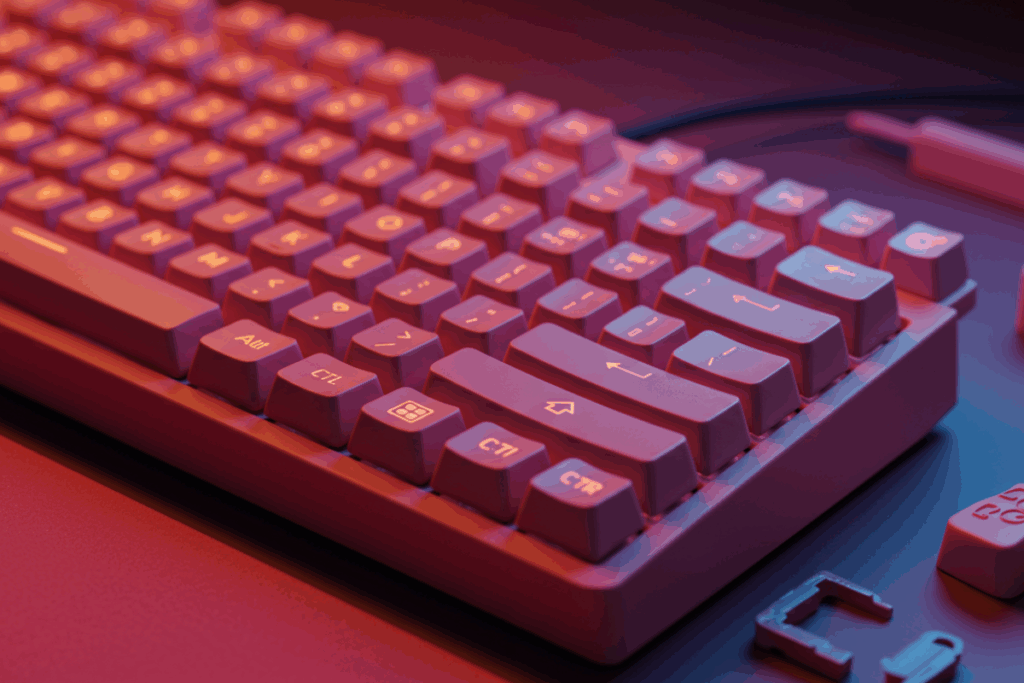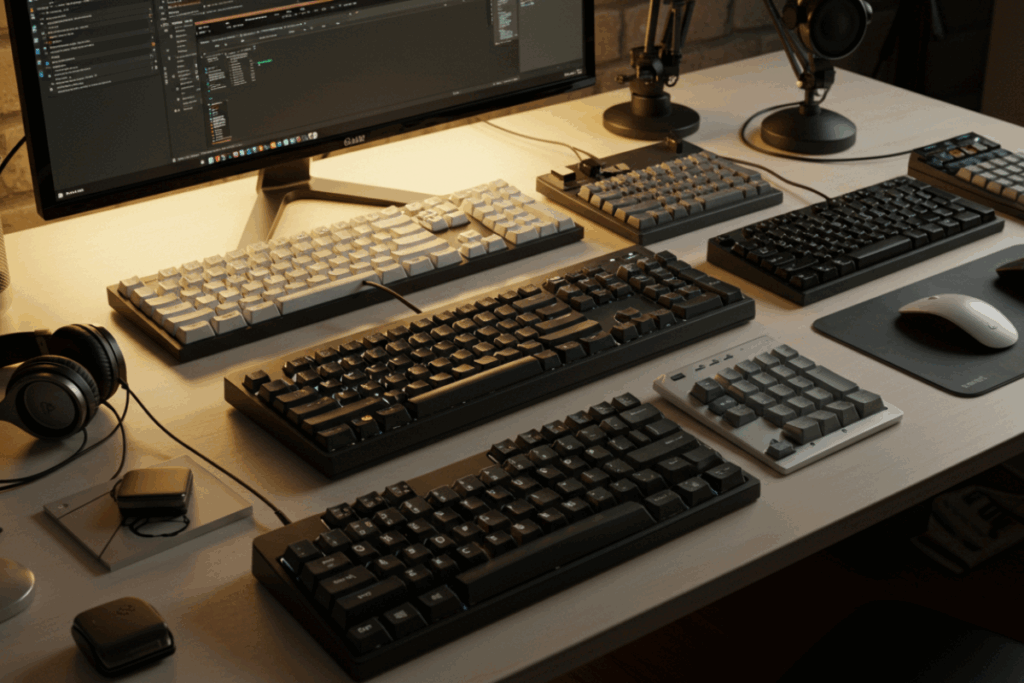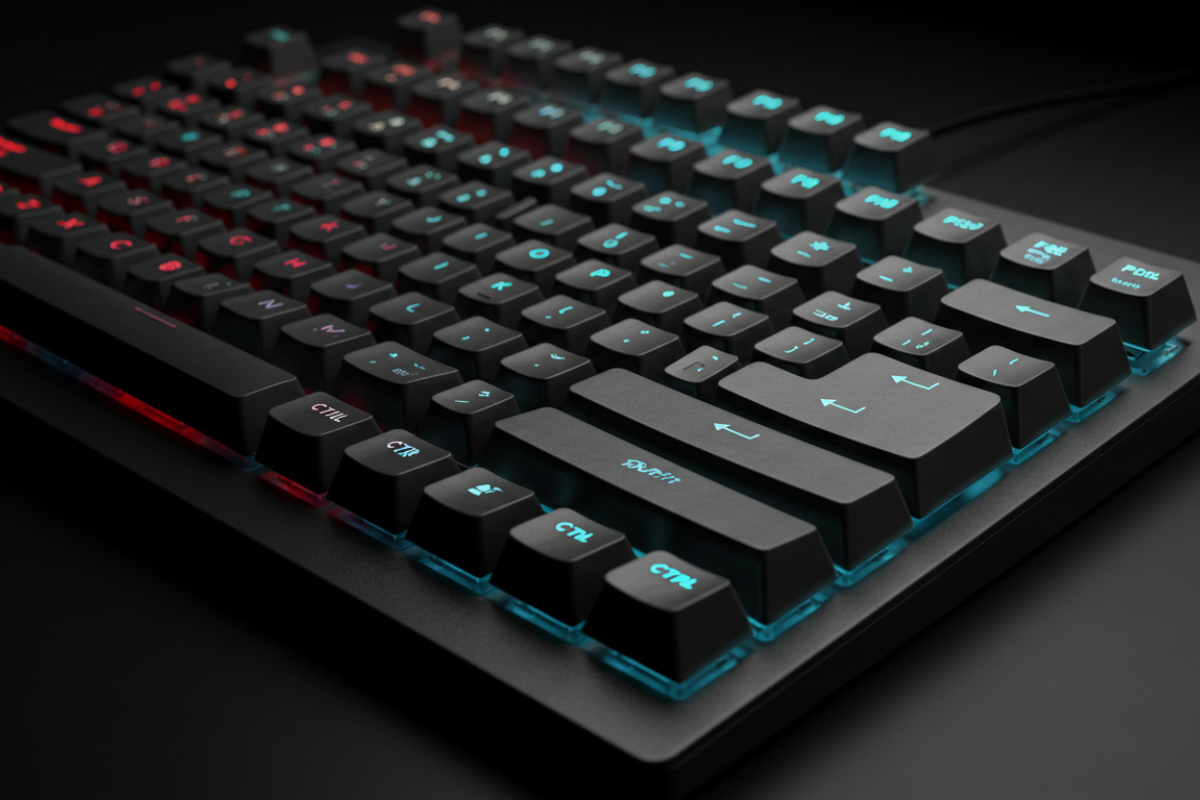Keyboards shape how I work and play. I wrote this guide for Keyboards Technology to walk you through the history, the basic parts, and the main types like mechanical, membrane, and low profile. I explain how switches, layouts, and connectivity change the feel.
I show how to choose for gaming, typing, and coding, and how to customize with keycaps, hot-swap options, and firmware. I also cover simple care tips and current trends so you can find a board that fits your hands and goals.
Key Takeaway
- I trust Keyboards Technology to explain mechanical, membrane, scissor, and optical keyboards.
- I pick switches by feel — linear, tactile, or clicky — and Keyboards Technology guides my choice.
- I choose a layout that fits me (full-size, TKL, 65%, 60%) with help from Keyboards Technology.
- I prefer hot-swap and wireless options for easy upgrades; Keyboards Technology highlights them.
- I keep my keyboard clean, pick PBT keycaps, and use Keyboards Technology tips for customization.
How I explain what Keyboards do
Basic parts: keys, switches, PCB and stabilizers
I break a keyboard down into four parts — it makes understanding simple.
- Keys (keycaps): The parts I press every day. PBT keycaps last longer; ABS can shine sooner.
- Switches: The heart of the feel. I pick linear for smooth presses, tactile for a bump, and clicky for sound. Typical actuation force: 35–60 g; travel ~4 mm; actuation ~1.5–2 mm.
- PCB (Printed Circuit Board): The brain. It reads presses and talks to the computer. Hot-swap PCBs let me change switches without soldering.
- Stabilizers: Big keys need balance. Good stabs stop rattle and make presses feel solid.
| Part | What I watch for | Why it matters |
|---|---|---|
| Keycaps | Material (PBT/ABS), profile | Durability and feel |
| Switches | Type, actuation force | Speed, sound, comfort |
| PCB | Hot-swap, firmware | Upgrades and programmability |
| Stabilizers | Clipped/lubed vs stock | Smoothness and noise control |
I trust Keyboards Technology gear because they get these parts right — their builds sound better and last longer.
How input is read: scanning, debounce, NKRO and rollover
When I press a key the PCB quickly tells the computer which key closed.
- Scanning: The PCB checks rows and columns and finds intersections.
- Debounce: Prevents one press from being read as many; typical 5–20 ms.
- NKRO (N-Key Rollover): Every key press is reported independently — important for combos and fast typing.
- 6KRO: Guarantees up to six simultaneous keys — fine for casual use, not ideal for competitive gaming.
| Feature | What it does | When I care |
|---|---|---|
| Scanning | Maps keys to matrix positions | Basic function |
| Debounce | Filters false repeats | Fast typists |
| NKRO | Registers every key press | Gaming, combos |
| 6KRO | Limited simultaneous keys | Office or casual use |
I test boards from Keyboards Technology by holding many keys and typing fast; their NKRO boards never miss a beat.
Function and common uses: typing, gaming, programming
A keyboard is more than a tool — it’s a daily partner.
- Typing: I choose tactile switches and PBT caps for long sessions.
- Gaming: I want low latency, NKRO, and sometimes linear switches. Macros and layers help mapping.
- Programming: I like compact layouts with programmable layers to save time.
Real example: remapping a macro halved a repetitive task — small tweaks like that add up.
Why I study the history and evolution of Keyboards
I study the history of Keyboards to understand why keys feel the way they do. The past informs today’s choices for switches, cases, and layouts.
From the typewriter to QWERTY layout and early electric boards
The typewriter gave us QWERTY — designed to slow typists and prevent jams — and that layout stuck. Electric typewriters and early electronic keyboards (IBM Selectric, etc.) moved toward electronic scanning and reliable switches.
| Era | What changed | Why it mattered |
|---|---|---|
| Typewriter (late 1800s) | Mechanical linkages, QWERTY | Set layout and key spacing |
| Electric typewriters (1930s–1960s) | Motorized actuation | Faster, less fatigue |
| Early electronic keyboards (1970s–1980s) | Electronic scanning | Digital input, easier to interface |
Key milestones: mechanical switches, USB interface and wireless adoption
Three milestones reshaped keyboard design:
- Mechanical switches: Clear feel and long life; Cherry MX, Gateron, Kailh, Topre, optical types followed.
- USB interface: Plug-and-play, power for features, easier firmware flashing.
- Wireless adoption: Bluetooth and 2.4 GHz freed desks but raised latency and battery questions.
| Milestone | When | Real effect |
|---|---|---|
| Mechanical switches | 1970s–1990s | Longer life, clear feel choices |
| USB standard | 1990s | Easy plug-and-play, more power |
| Wireless (Bluetooth/2.4 GHz) | 2000s–now | Portability, multi-device use |
How past inventions shaped modern mechanical keyboard design
Old ideas persist:
- Typewriter → standard layouts (ANSI, ISO, JIS).
- Electric actuation → precise switch electronics, hot-swap, programmable scanning.
- Case materials evolved → aluminum or brass for weight, sound.
- Keycap tech → PBT, doubleshot, dye-sublimation.
| Old tech | Modern outcome |
|---|---|
| QWERTY/typewriter | Standard layouts & spacing |
| Electric actuation | Reliable switch electronics, NKRO |
| Mechanical switch families | Wide switch choices, modding culture |
| Early keycaps | PBT, doubleshot legends |
A single old idea can ripple through decades — the click of a typebar still echoes in a clicky switch today.
How I compare types of Keyboards and mechanical switches
Mechanical vs membrane vs scissor-switch vs chiclet
I test feel, noise, lifespan, and price.
- Mechanical: Crisp feel, long life (~50M keystrokes), mod-friendly, louder if clicky.
- Membrane (rubber dome): Quiet, cheap, mushy feel, shorter life.
- Scissor-switch: Low-profile (laptops), stable, faster than rubber dome.
- Chiclet: Flat keys for slim designs and travel.
| Type | Feel | Lifespan | Noise | Best for |
|---|---|---|---|---|
| Mechanical | Crisp, firm | 50M | Medium–High | Gamers, typists, tinkerers |
| Membrane | Soft, squishy | 5–10M | Low | Budget office use |
| Scissor-switch | Low-profile, stable | 10–30M | Low | Laptops, office travel |
| Chiclet | Shallow, flat | 10–20M | Low | Portable devices |
Swapping a cheap membrane for a mechanical boosted my typing speed — the click made me smile.

Switch types: linear, tactile, clicky and brands
I judge switches by feel and sound with short tests (rapid typing, long typing, gaming bursts).
- Linear: Smooth, consistent — good for fast presses.
- Tactile: Bump on actuation — better accuracy.
- Clicky: Bump audible click — satisfying but loud.
Common makers: Cherry MX, Gateron, Kailh, Topre.
| Switch Type | Feel | Sound | Typical Users |
|---|---|---|---|
| Linear | Smooth | Low–Medium | Gamers |
| Tactile | Bump on actuation | Medium | Typists, coders |
| Clicky | Bump click | High | Typists who like sound |
| Topre | Cushioned, hybrid | Low–Medium | Typists wanting plush feel |
I prefer tactile for long typing and linear for fast gaming. Topre is for late-night writing — plush and quiet.
Choose switches by actuation force, travel distance and sound
Match switches to your goals.
| Goal | Actuation Force (g) | Travel Distance (mm) | Sound |
|---|---|---|---|
| Fast gaming | 35–45g | Short (1.5–2.0) | Quiet–medium |
| Typing comfort | 45–60g | Medium (2.0–4.0) | Medium |
| Quiet office | 30–50g | Short–medium | Low (silenced) |
Quick rules:
- For speed: lower actuation force and shorter travel.
- For fewer mistakes: tactile bump.
- For shared spaces: quiet or silenced switches.
- If you mod: pick hot-swap so you can try switches fast.
I listen for pitch and ring — a deep thud is pleasant; a bright ping may need foam or weight.
How I choose sizes and layouts: full-size, tenkeyless and compact Keyboards
Layouts: full-size, TKL, 75%, 65%, 60%, 40%
I match layout to work and desk space.
- Need numbers: full-size.
- Want desk space: Tenkeyless (TKL).
- Compact but keep arrows: 75% or 65%.
- Ultra portable: 60% or 40%.
| Layout | Typical keys | Footprint | Pros | Cons | Best for |
|---|---|---|---|---|---|
| Full-size | 104/105 | Largest | Full numpad | Large | Data entry |
| TKL | ~87 | Medium | More desk space | No numpad | Coding, desktop |
| 75% | ~84 | Compact | Arrows included | Learning curve | Typists wanting arrows |
| 65% | ~68 | Small | Arrows, compact layers | No function row | Programmers |
| 60% | ~61 | Very small | Super portable | Heavy layer use | Travelers |
| 40% | ~40 | Tiny | Ultra portable | Heavy layer use | Enthusiasts |
Check keycap profile, switch type, and whether the board is hot-swap. A hot-swap TKL gives layout flexibility plus easy switch changes.
ANSI vs ISO, ortho and split options plus language distributions
Pick standards by region and habit.
- ANSI: wide Enter, long left Shift — common in US.
- ISO: tall Enter, split left Shift — common in Europe.
- JIS: adds keys for Japanese input.
Ortholinear and split styles:
- Ortholinear: grid layout — uniform finger motion.
- Split: two halves — better posture and reduced strain.
Language layouts: QWERTY, AZERTY, QWERTZ — match layout to your language to avoid relearning.
| Option | What changes | Why I pick it |
|---|---|---|
| ANSI | Key shape/Enter | US layout users |
| ISO | Enter/Shift | European users |
| Ortho | Grid layout | Consistent finger motion |
| Split | Two halves | Reduce wrist strain |
| Language layouts | Legends and positions | Match typing language |
I always check product photos on Keyboards Technology to avoid surprises.
Consider an ergonomic split keyboard or tenting for comfort
I switched to a split board when wrists hurt — it felt like better shoes. Look for:
- Tenting or adjustable angle.
- Negative tilt for neutral wrists.
- A good wrist rest and comfortable keycap profile.
For long sessions I prefer split with tenting and softer switches — it cut my wrist soreness.
How I customize Keyboards with keycaps, mods and hot-swap options
Keycap materials and profiles: ABS vs PBT, doubleshot, dye-sublimation, OEM, Cherry, SA, DSA
Keycaps change feel and sound.
| Material / Method | Feel | Durability | Legibility |
|---|---|---|---|
| ABS | Smooth, can be slick | Prone to shine | Pad-print can fade |
| PBT | Slightly textured, firmer | Very resistant to shine | Holds legends well |
| Doubleshot | Depends on base | Legends never wear off | Crisp legends |
| Dye-sublimation | Same as base | Legends soak into plastic | Very durable |
Profiles:
| Profile | Height & Shape | Typing note |
|---|---|---|
| OEM | Medium sculpted | Comfortable for most |
| Cherry | Lower sculpted | Faster travel |
| SA | Tall, spherical | Deep, thocky sound |
| DSA | Low, uniform | Easy for column swaps |
I favor PBT for firmer feel and less shine; doubleshot or dye-sublimation for lasting legends.
Hot-swappable keyboards, lubing, stabilizer mods and firmware like QMK/VIA
I love hot-swap boards — they let me test switches fast. My routine:
- Choose a hot-swappable board from Keyboards Technology.
- Lube switches (stem rails and spring) for smoother travel and less scratch.
- Clip and lube stabilizers; add a film to reduce rattle.
- Use QMK for deep remaps and macros; VIA for quick GUI changes.
Workflow:
- Pick switches and keycaps.
- Swap on a hot-swap board.
- Lube scratchy switches.
- Tune stabilizers (clip, lube, film).
- Flash layout tweaks with QMK or adjust with VIA.
I often test actuation and travel charts from Keyboards Technology to match switches to tasks.
Hot-swap makes swapping switches and keycaps easy
I moved my main boards to hot-swap sockets — a full switch set in under 15 minutes. No soldering, no fear. That fast loop keeps typing fresh.
How I pick connectivity, features, and care for Keyboards
Wired USB vs wireless Bluetooth: latency, polling rate, battery and use cases
I test both wired and wireless models before buying.
| Metric | Wired USB | Bluetooth |
|---|---|---|
| Latency | Very low — best for gaming | Higher than wired; fine for typing |
| Polling rate | 1000 Hz common (1 ms) | Not applicable — different timing |
| Battery | No battery worries | Hours to weeks depending on lights |
| Reliability | Stable, no drops | Can drop in busy wireless areas |
| Use case | Competitive gaming | Travel, multi-device, clean desk |
If I need the lowest latency, I pick wired. For convenience and multi-device, I go Bluetooth or 2.4 GHz dongle for a middle ground.
Features to compare: RGB, onboard memory, macros and software
I focus on features that affect daily use.
| Feature | What it does | Why I care | When I pick it |
|---|---|---|---|
| RGB backlight | Per-key lighting | Visibility, style | Streaming, night typing |
| Onboard memory | Saves profiles | Keeps settings without software | Travel, multiple PCs |
| Macros | Record complex keystrokes | Speeds repetitive tasks | Productivity, MMO play |
| Software support | Configure keys/lighting | Deeper customization | Layers, remaps, firmware |
I always check if a board supports QMK/VIA or Keyboards Technology firmware and whether profiles can be stored onboard.
Buying tips plus simple maintenance: cleaning, keycap removal and basic troubleshooting
I buy with a checklist and keep the keyboard clean.
Buy tips:
- Pick the right switch type for your fingers.
- Choose PBT keycaps for long-lasting legends.
- Prefer hot-swap if you want to swap switches later.
- Check connectivity: wired, Bluetooth, 2.4 GHz.
- Look for onboard memory if you travel or use multiple PCs.
Maintenance:
- Unplug or switch off the keyboard.
- Use compressed air weekly to blow crumbs.
- Remove keycaps with a puller for a deeper clean every 3–6 months.
- Wipe frame with a damp cloth and let everything dry before reassembly.
| Task | Tool | How often |
|---|---|---|
| Quick dust | Compressed air | Weekly |
| Deep clean | Keycap puller, mild soap | Every 3–6 months |
| Stabilizer care | Small brush, lubricant | When scratchy |
| Firmware updates | USB cable | As released |
Troubleshooting:
- Sticky key: remove cap and clean.
- Wireless drops: test range, battery, re-pair.
- Macro issues: reset profile and reload firmware/app.
I once spilled coffee and saved a board by removing caps, cleaning, and drying — keep a small toolkit handy.

Quick buying guide for Keyboards (SEO-friendly)
- Decide what you do most: typing, gaming, or programming.
- For typing: choose tactile switches and PBT keycaps.
- For gaming: favor linear switches, NKRO, and wired USB for lowest latency.
- For tinkering: get a hot-swap board and learn QMK/VIA.
- For travel and multi-device: pick Bluetooth or 2.4 GHz wireless.
- Always check layout (ANSI/ISO/JIS) and physical footprint (full-size/TKL/60%).
Conclusion
I started this guide because Keyboards shape how I work and play. After testing dozens of boards, I return to a few truths: pick the right switch for your fingers (tactile for long typing, linear for fast gaming), choose a layout that fits your desk and workflow, and opt for hot-swap and PBT keycaps if you like to tinker. Those choices change feel more than any flashy RGB.
Treat a keyboard like a trusty tool: the PCB and stabilizers are the frame; NKRO, debounce, and firmware like QMK/VIA are the brain. Wireless and wired each have their place — Bluetooth for convenience, USB for rock-solid latency. Simple maintenance and a little lubing go a long way.
If you’re overwhelmed, start small: decide what feels good, then iterate. Swap a switch, change a cap, adjust a layer. The right keyboard should disappear under your fingers — helping you move faster, longer, and with less fuss.
Frequently Asked Questions
Q: What types of Keyboards does Keyboards Technology offer?
A: Mechanical, membrane, scissor-switch, hybrid, ergonomic, and compact sizes like 60%, 65%, TKL, and full-size.
Q: Why choose a mechanical Keyboard from Keyboards Technology?
A: For feel, durability, and customization. Switches last 50M presses; caps are swappable; stabilizers tunable.
Q: What does hot-swappable mean for Keyboards Technology models?
A: You can change switches without soldering — fast experimentation.
Q: Wired or wireless Keyboards — which do I recommend?
A: Wired for lowest latency and no charging. Wireless for clean desks and mobility.
Q: How do I clean and maintain my Keyboards from Keyboards Technology?
A: Unplug, use compressed air for crumbs, remove keycaps for deep cleaning in mild soap, and dry fully before reassembly.

